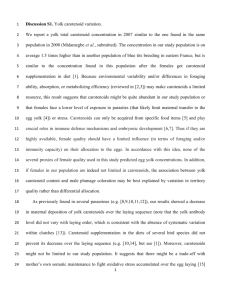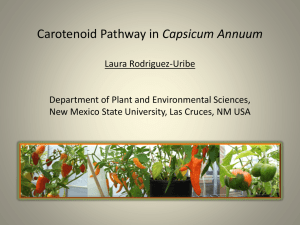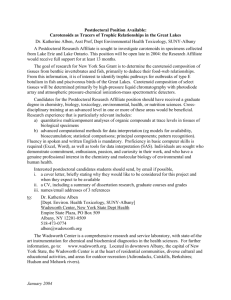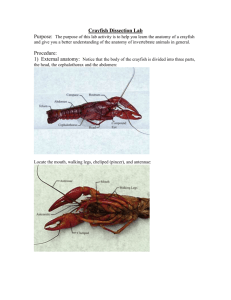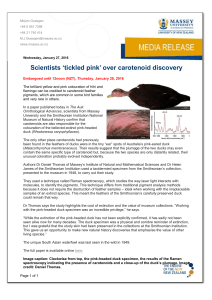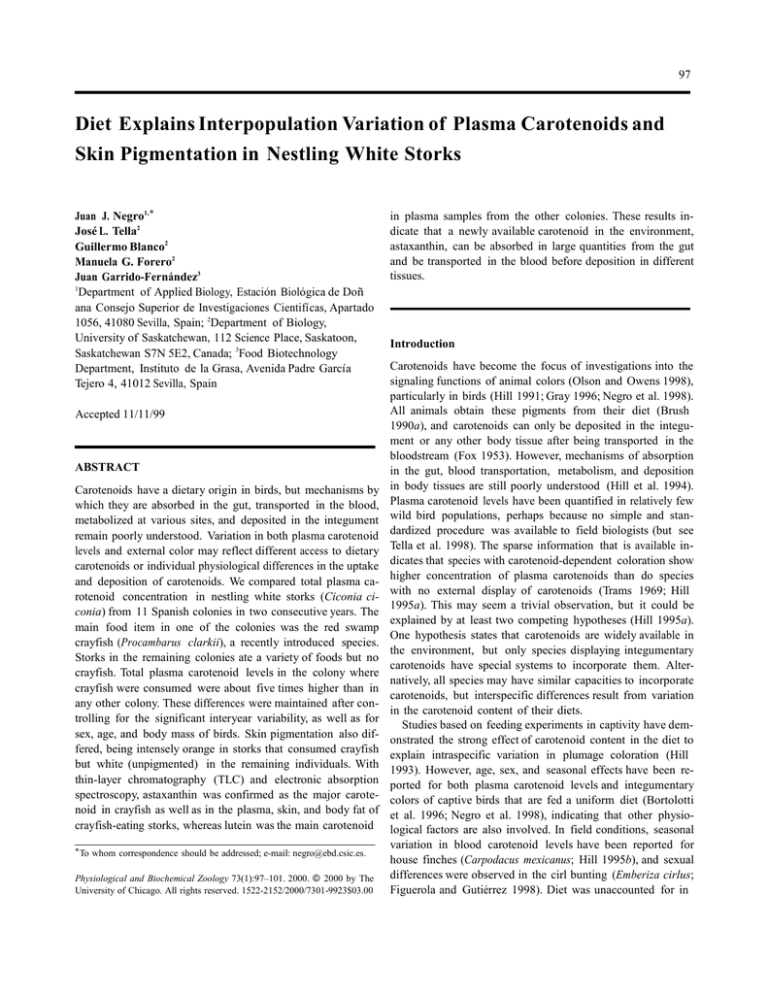
97
Diet Explains Interpopulation Variation of Plasma Carotenoids and
Skin Pigmentation in Nestling White Storks
Juan J. Negro1, *
José L. Tella2
Guillermo Blanco2
Manuela G. Forero2
Juan Garrido-Fernández3
1
Department of Applied Biology, Estación Biológica de Doñ
ana Consejo Superior de Investigaciones Cientifı́cas, Apartado
1056, 41080 Sevilla, Spain; 2Department of Biology,
University of Saskatchewan, 112 Science Place, Saskatoon,
Saskatchewan S7N 5E2, Canada; 3Food Biotechnology
Department, Instituto de la Grasa, Avenida Padre Garcı́a
Tejero 4, 41012 Sevilla, Spain
Accepted 11/11/99
ABSTRACT
Carotenoids have a dietary origin in birds, but mechanisms by
which they are absorbed in the gut, transported in the blood,
metabolized at various sites, and deposited in the integument
remain poorly understood. Variation in both plasma carotenoid
levels and external color may reflect different access to dietary
carotenoids or individual physiological differences in the uptake
and deposition of carotenoids. We compared total plasma carotenoid concentration in nestling white storks (Ciconia ciconia) from 11 Spanish colonies in two consecutive years. The
main food item in one of the colonies was the red swamp
crayfish (Procambarus clarkii), a recently introduced species.
Storks in the remaining colonies ate a variety of foods but no
crayfish. Total plasma carotenoid levels in the colony where
crayfish were consumed were about five times higher than in
any other colony. These differences were maintained after controlling for the significant interyear variability, as well as for
sex, age, and body mass of birds. Skin pigmentation also differed, being intensely orange in storks that consumed crayfish
but white (unpigmented) in the remaining individuals. With
thin-layer chromatography (TLC) and electronic absorption
spectroscopy, astaxanthin was confirmed as the major carotenoid in crayfish as well as in the plasma, skin, and body fat of
crayfish-eating storks, whereas lutein was the main carotenoid
* To whom correspondence should be addressed; e-mail: negro@ebd.csic.es.
Physiological and Biochemical Zoology 73(1):97–101. 2000. © 2000 by The
University of Chicago. All rights reserved. 1522-2152/2000/7301-9923$03.00
in plasma samples from the other colonies. These results indicate that a newly available carotenoid in the environment,
astaxanthin, can be absorbed in large quantities from the gut
and be transported in the blood before deposition in different
tissues.
Introduction
Carotenoids have become the focus of investigations into the
signaling functions of animal colors (Olson and Owens 1998),
particularly in birds (Hill 1991; Gray 1996; Negro et al. 1998).
All animals obtain these pigments from their diet (Brush
1990a), and carotenoids can only be deposited in the integument or any other body tissue after being transported in the
bloodstream (Fox 1953). However, mechanisms of absorption
in the gut, blood transportation, metabolism, and deposition
in body tissues are still poorly understood (Hill et al. 1994).
Plasma carotenoid levels have been quantified in relatively few
wild bird populations, perhaps because no simple and standardized procedure was available to field biologists (but see
Tella et al. 1998). The sparse information that is available indicates that species with carotenoid-dependent coloration show
higher concentration of plasma carotenoids than do species
with no external display of carotenoids (Trams 1969; Hill
1995a). This may seem a trivial observation, but it could be
explained by at least two competing hypotheses (Hill 1995a).
One hypothesis states that carotenoids are widely available in
the environment, but only species displaying integumentary
carotenoids have special systems to incorporate them. Alternatively, all species may have similar capacities to incorporate
carotenoids, but interspecific differences result from variation
in the carotenoid content of their diets.
Studies based on feeding experiments in captivity have demonstrated the strong effect of carotenoid content in the diet to
explain intraspecific variation in plumage coloration (Hill
1993). However, age, sex, and seasonal effects have been reported for both plasma carotenoid levels and integumentary
colors of captive birds that are fed a uniform diet (Bortolotti
et al. 1996; Negro et al. 1998), indicating that other physiological factors are also involved. In field conditions, seasonal
variation in blood carotenoid levels have been reported for
house finches (Carpodacus mexicanus; Hill 1995b), and sexual
differences were observed in the cirl bunting (Emberiza cirlus;
Figuerola and Gutiérrez 1998). Diet was unaccounted for in
100 J. J. Negro, J. L. Tella, G. Blanco, M. G. Forero, and J. Garrido-Ferná ndez
both studies, and the authors admitted that they were unable
to determine whether variation in circulating levels of carotenoids was due to dietary differences or to individual physiological differences in the uptake of carotenoids. As with interspecific studies, a debate persists (Hudon 1994; Linville and
Breitwisch 1997; Olson and Owens 1998) on whether carotenoids are limiting in the environment.
In this study, we compared carotenoid composition and
concentration in the plasma of nestling white storks (Ciconia
ciconia) that eat mainly the recently introduced red swamp
crayfish (Procambarus clarkii), a rich source of crustacean
astaxanthin, with those in nestlings that eat the usual diets
of fish, arthropods, meat scraps from refuse dumps, and
earthworms, all of which contain much lower levels of carotenoids. Our aim was to determine whether the blood system in a given bird species (in this case the white stork) is
very specific in the amount and type of carotenoids that it
can transport or whether it reflects the amount of carotenoids
in the diet. In addition, we investigated other possible sources
Figure 1. Plasma carotenoid concentration (mg/mL) in nestlings from
of individual variation, such as sex, body mass, nestling age, 11 white stork colonies in Spain. Red swamp crayfish was consumed
and year effects.
exclusively in colony C. Codes for colonies: A, Jeréz Zoo (Cá diz); B,
Material and Methods
Fieldwork was conducted in May–June of 1998 and 1999 in 11
white stork colonies in southern (the provinces of Sevilla,
Huelva, and Cádiz) and central Spain (province of Madrid; Fig.
1). The colonies at Jerez, Arahal, and Dehesa de Abajo were
sampled during both years of the study, and the remaining
colonies were sampled either in 1998 or in 1999. Crayfish were
only consumed in the Dehesa de Abajo colony, located in the
northern boundary of Doñ ana National Park. The red swamp
crayfish is a nonnative species introduced in southern Spain
from the United States in 1973 (Senra and Alés 1992). It has
expanded rapidly throughout the Guadalquivir marshes and
Doñ ana National Park, affecting the whole ecosystem (Delibes
and Adrián 1987). White storks in the Dehesa de Abajo colony
incorporated crayfish in their diet soon after its introduction
in the marshes. Most pellets and remains in the nests consisted
mainly of crayfish in the early 1980s (Rubio et al. 1983). During
the sampling period, crayfish remains were observed in 62
(82.7%) of 75 nests with chicks, and they were the only remains
in 41 (54.7%) nests with chicks. No crayfish were seen among
the nest remains in the other colonies. Instead, we recorded a
variety of natural prey (fish, arthropods, earthworms), as well
as meat scraps brought by the adult storks from nearby refuse
dumps. Individually banded breeding adults (N = 57) from
these colonies were not observed preying on crayfish during
foraging activities (Blanco 1996; J. Marchamalo and G. Blanco,
unpublished data).
Arahal (Sevilla); C, Dehesa de Abajo (Sevilla); D, Soto del Real (Madrid); E, Rivas-Vaciamadrid (Madrid); F, Lozoya (Madrid); G, Guadalix
(Madrid); H, Marchena (Sevilla); I, Dos Hermanas (Sevilla); J, Aznalcázar (Sevilla); K, Villanueva (Huelva). Black dots correspond to
1998 and open dots to 1999; sample sizes are above the codes for
colonies.
Biological Materials
We collected about 0.5 mL of blood from the brachial veins of
98 nestlings in Dehesa de Abajo and 109 nestlings from the
remaining colonies. Blood was transported in coolers to the
laboratory on the day of collection and centrifuged to separate
blood cells from plasma. Both fractions were frozen for subsequent analyses.
From a freshly dead adult found in April 1999 near the
Dehesa de Abajo colony, we collected skin samples (wing and
neck) that were bright orange like those of the nestlings, as well
as a portion of the red-colored fat. Five live crayfish were also
collected for analysis.
Extraction Procedure
Three volumes of acetone were added to the plasma samples,
and then the mixture was centrifuged at 13,000 g for 10 min.
The supernatant was analyzed. Skin and fat samples were
weighed and then placed in ethyl ether for 2 h. The filtrate
containing the carotenoids was evaporated, and the residue was
redissolved in acetone before analysis. The crayfish were first
ground in a blender and then extracted as described above for
skin and fat samples.
Carotenoids in White Storks 99
Quantitative Determination of Carotenoids
Total plasma carotenoid content was measured spectrophotometrically (Pharmacia Biotech, Ultrospec 2000 UV/Vis) by using acetone as a solvent and recording absorbance at 476 nm
(Tella et al. 1998). Plasma carotenoid concentration was estimated as micrograms per milliliter of plasma by using a standard curve of lutein. Concentration values are given as
mean ± SD. The absorption maxima for astaxanthin in acetone
is 480 nm (Britton 1995); thus, the actual plasma carotenoid
concentration for birds that ingested astaxanthin may be
slightly underestimated.
Carotenoid Identification
For carotenoid separation and comparison with reference astaxanthin, we used thin-layer chromatography (TLC), following
the methods of Mı́nguez-Mosquera and Garrido-Ferná ndez
(1989) and Muriana et al. (1993). In addition, electronic absorption spectra were carried out for the different tissues by
using a diode-array spectrophotometer (Hewlett-Packard UVVis spectrophotometer 8452A, controlled by the HP Chem Station V.A. 02.05). As references, we used astaxanthin that was
kindly supplied by Hoffman-La Roche (Roche, Madrid), as well
as lutein from spinach extracted in our laboratory.
Sex and Age Determination
0.03) between each of those colonies and the Dehesa de Abajo
colony.
To examine potential confounding effects on differences in
plasma carotenoids related to diet, an ANCOVA was performed with diet (crayfish vs. no crayfish), year, and sex as
factors and body mass and age as covariates. There were no
significant effects of sex (F1, 157 = 0.4, P = 0.53), age (F1, 157 =
2.9, P = 0.09), or body mass (F1, 157 = 2.4, P = 0.12) on carotenoid concentration. However, there was a significant year
effect (F1, 157 = 5.6, P = 0.02). Total plasma carotenoids were
higher in 1998 than in 1999 in both Dehesa de Abajo
(12.4 ± 2.9 mg/mL, N = 44 vs. 9.9 ± 3.7 mg/mL, N = 54) and
Jeréz (2.8 ± 0.7 mg/mL, N = 11 vs. 1.1 ± 0.3 mg/mL, N = 12).
This trend was opposite for Arahal, although it could be influenced by the small sample size (Fig. 1). After controlling
for the preceding effects, we found that crayfish-eating storks
still differed from storks in other populations in plasma carotenoid contents (F1, 157 = 218, P ! 0.001).
Carotenoid Identification
TLC showed that the extract from the plasma of five randomly
selected crayfish-eating storks showed a single red band, coincidental in color and relative mobility (i.e., Rf value) with
those of reference astaxanthin, crayfish, fat, and skin extracts
from the adult stork. In 10 randomly selected storks from the
colonies where crayfish were not present in the diet, there was
a single yellow band identical to reference lutein. The electronic
absorption spectra of plasma, skin, and fat from crayfish-eating
storks, crayfish, and reference astaxanthin were the same, all
showing a broad absorption band and single absorption maxima at 468 nm in hexane. The plasma samples from the remaining storks showed absorption spectra shaped like the reference lutein spectrum.
Sex and age may affect carotenoid content in bird plasma (Hill
et al. 1994; Bortolotti et al. 1996). In the white stork, both
sexes look alike, and we resorted to molecular sexing of the
birds by using the cellular fraction of the blood as a source of
DNA. For this analysis, primers 2945F, cfR, and 3224R were
used, following the method of Ellegren (1996). At the time of
blood sampling, we recorded body mass and wingchord length
from each nestling. Nestling age was estimated according to a
regression equation of age on wingchord (age = 5.068 +
0.117 # wingchord length, r = 0.99, N = 12, P ! 0.01), calcu- Discussion
lated with data from nestlings whose hatch date was known It is well known from feeding experiments of birds in captivity
(Chozas 1983).
(Hill 1993) and from zoo keeping (Fox and McBeth 1970)
that carotenoid additives enhance plumage colors in birds
with carotenoid-based plumage. However, few measurements
of carotenoids in the plasma transport system are available
Results
(Brush 1981), and interpretation of some results is controQuantification of Plasma Carotenoids
versial. Fox and McBeth (1970) supplemented the diet of
Mean plasma carotenoid concentrations were higher in nest- flamingos with astaxanthin, but plasma carotenoid levels aclings in the Dehesa de Abajo colony (11.1 ± 3.6 mg/mL, N = tually dropped. Hudon (1994) criticized experiments that
98) than in other colonies as a whole (2.2 ± 1.0 mg/mL, N = used canthaxanthin because this pigment is unusual in natural
109; Fig. 1). These differences were significant when colony was bird diets.
The pioneering study by Slagsvold and Lifjeld (1985) clearly
used as a grouping factor in one-way ANOVA (F10, 196 = 121.7,
P ! 0.001). Tukey’s HSD tests indicated no significant differ- linked intrapopulation variation in plumage brightness to caences in pairwise comparisons of any of the noncrayfish col- rotenoid content in the diet, but plasma carotenoid levels were
onies (P 1 0.98), whereas differences were all significant (P ! not determined. More recently, Hill et al. (1994) reported in-
100 J. J. Negro, J. L. Tella, G. Blanco, M. G. Forero, and J. Garrido-Ferná ndez
terpopulation variation in plasma carotenoid levels that could
be attributable to diet, but the latter was not examined. Therefore, our study constitutes a demonstration of differences in
plasma carotenoid levels among populations of the same bird
species that result from variation in the carotenoid content and
composition in the diet. Total plasma carotenoids were about
five times higher in nestling storks whose diet was primarily
crayfish compared to nestlings that ate typical foods. In fact,
there was no overlap in carotenoid values between the two diet
groups. In an interspecific study on plasma carotenoid levels
involving 26 bird species, Tella et al. (1998) reported a mean
carotenoid concentration of 9.4 mg/mL (range 0.43–74.16 mg/
mL). Taking these data as a reference, we found that crayfisheating storks showed above-average carotenoid concentration,
whereas those of the other nestlings were in the low range for
birds.
Crayfish are indeed a rich source of astaxanthin, and our
results demonstrate that this pigment was able to reach the
blood of nestling storks. We can thus conclude that this newly
available carotenoid in the environment is absorbed in large
quantities and that the mechanisms responsible for the transport of carotenoids in the stork are not selective against
astaxanthin.
White storks do not have carotenoids in their feathers, but
because of carotenoids, adults show an intense red color in the
bill, legs, and bare skin of the chin and throat. In nestling storks,
the color of the bill and legs is typically black with interspersed
dull orange parts. We noticed that nestlings in the Dehesa de
Abajo colony presented a red color in the legs and bill, similar
to that in adults, as well as intense and uniform orange coloration in the skin, particularly under the wings and on the
abdomen. Nestlings in the other colonies presented whitish
(unpigmented) skin. These observations and the qualitative carotenoid determinations that we performed on the dead adult
stork indicate that the astaxanthin ingested by crayfish-eating
storks diffused from the blood to the integument, probably in
a nonspecific form, as suggested by Hudon (1994) for cases in
which carotenoids are present in large quantities. It is noteworthy that carotenoids did not appear in the feathers; this
suggests that physiological processes regulate which tissues are
suitable targets for deposition and which are not. Yellow skin
coloration caused by ingestion of large amounts of lutein has
been reported in humans (Mathews-Roth 1981). This condition
has been called “carotenodermia,” a name that we might well
apply to the crayfish-eating storks. In birds, a case of change
in the normal pigmentation has recently been reported (Hudon
and Brush 1989; Brush 1990b) for the plumage of free-living
cedar waxwings (Bombycilla cedrorum) in the United States.
The color shift from yellow to orange was linked to the consumption of fruits of an introduced shrub containing rhodoxanthin, a carotenoid pigment not present in the typical diet of
cedar waxwings.
Consumption of crayfish by white storks is not likely to be
a rarity in the near future. Red swamp crayfish are quickly
expanding in Spain (Senra and Alé s 1992) and can be found
in many rivers and reservoirs in the southern part of the country. This species has been recently introduced in other European
countries, such as Italy and France, where white storks occur
and may incorporate the crayfish into their diets. Given that
carotenoids may provide health benefits as antioxidants (Bendich 1989; Lozano 1994; Surai and Speake 1998), further research is needed to determine whether storks with high levels
of astaxanthin caused by ingesting the crayfish will have any
physiological effects compared with storks showing only moderate to low levels of lutein.
Acknowledgments
We thank the personnel of the Equipo de Seguimiento de Procesos Naturales for their help in collecting samples in the Dehesa de Abajo. J. Marchamalo and M. de la Riva shared unpublished data on diet and movements of white storks in
Madrid province and Arahal, respectively. The staff of Jeréz
Zoo (M. A. Quevedo, I. Sánchez, J. M. Aguilar, and M. Barcell)
helped to sample the storks from the zoo. Comments from two
referees greatly improved the manuscript. J.J.N., J.L.T., G.B.,
and M.G.F. were supported by postdoctoral grants from the
Consejo Superior de Investigaciones Cientı́ficas and Ministerio
de Educació n y Ciencia, respectively. J. A. Godoy performed
the molecular sexing. The North Atlantic Treaty Organization
(NATO) supported our research on carotenoids through its
Collaborative Research Grant Programme.
Literature Cited
Bendich A. 1989. Carotenoids and the immune response. Am
J Nutr 119:112–115.
Blanco G. 1996. Population dynamics and communal roosting
of white storks foraging at a Spanish refuse dump. Colon
Waterbirds 19:273–276.
Bortolotti G.R., J.J. Negro, J.L. Tella, T.A. Marchant, and D.M.
Bird. 1996. Sexual dichromatism in birds independent of
diet, parasites and androgens. Proc R Soc Lond B Biol Sci
263:1171–1176.
Britton G. 1995. UV/Visible spectroscopy. Pp. 13–62 in G. Britton, S. Liaaen-Jensen, and H. Pfander, eds. Carotenoids:
Spectroscopy. Vol. 1B. Birkhauser, Basel.
Brush A.H. 1981. Carotenoids in wild and captive birds. Pp.
539–562 in J.C. Bauernfeind, ed. Carotenoids as Colorants
and Vitamin A Precursors. Academic Press, New York.
———. 1990a. Metabolism of carotenoid pigments in birds.
FASEB J 4:2969–2977.
———. 1990b. A possible source for the rhodaxanthin in some
cedar waxwing tails. J Field Ornithol 61:355.
Chozas P. 1983. Estudio general sobre la población de la di-
Carotenoids in White Storks 101
námica de población de la cigüeña Ciconia ciconia en España.
PhD diss. Universidad Complutense de Madrid.
Delibes M. and M.I. Adrián. 1987. Effects of crayfish introduction on otter Lutra lutra food in the Doñ ana National
Park, SW Spain. Biol Conserv 42:153–159.
Ellegren H. 1996. First gene on the avian W chromosome
(CHD) provides a tag for universal sexing of non-ratite birds.
Proc R Soc Lond B Biol Sci 263:1635–1641.
Figuerola J. and R. Gutiérrez. 1998. Sexual differences in levels
of blood carotenoids in the cirl bunting (Emberiza cirlus).
Ardea 86:245–248.
Fox D.L. 1953. Animal Biochromes and Structural Colours.
Cambridge University Press, Cambridge.
Fox D.L. and J.W. McBeth. 1970. Some dietary carotenoids and
blood carotenoid levels in flamingos. Comp Biochem Physiol
34:707–713.
Gray D.A. 1996. Carotenoids and sexual dichromatism in North
American passerine birds. Am Nat 148:453–480.
Hill G.E. 1991. Plumage colouration is a sexually selected indicator of male quality. Nature 350:337–339.
———. 1993. The proximate basis of inter- and intra-population variation in female plumage colouration in the house
finch. Can J Zool 71:619–627.
———. 1995a. Interspecific variation in plasma hue in relation
to carotenoid plumage pigmentation. Auk 112:1054–1057.
———. 1995b. Seasonal variation in circulating carotenoid pigments in the house finch. Auk 112:1057–1061.
Hill G.E., R. Montgomerie, C.Y. Inouye, and J. Dale. 1994.
Influence of dietary carotenoids on plasma and plumage colour in the house finch: intra- and intersexual variation. Funct
Ecol 8:343–350.
Hudon J. 1994. Showiness, carotenoids and captivity: a comment on Hill (1992). Auk 111:218–221.
Hudon J. and A.H. Brush. 1989. Probable dietary basis of a
color variant of the cedar waxwing. J Field Ornithol 60:
361–368.
Linville S.U. and R. Breitwisch. 1997. Carotenoid availability
and plumage coloration in a wild population of northern
cardinals. Auk 114:796–800.
Lozano G. 1994. Carotenoids, parasites, and sexual selection.
Oikos 70:309–311.
Mathews-Roth M.M. 1981. Carotenoids in medical applications. Pp. 755–785 in J.C. Bauernfeind, ed. Carotenoids as
Colorants and Vitamin A Precursors. Academic Press, New
York.
Mı́nguez-Mosquera M.I. and J. Garrido-Ferná ndez. 1989. Chlorophyll and carotenoid presence in olive fruit (Olea europaea). J Agr Food Chem 37:1–7.
Muriana F.J.G., V. Ruiz-Gutierrez, M.L. Gallardo-Guerrero, and
M.I. Mı́nguez-Mosquera. 1993. A study of the lipids and
carotenoprotein in the Prawn, Penaeus japonicus. J Biochem
114:223–229.
Negro J.J., G.R. Bortolotti, J.L. Tella, K.J. Fernie, and D.M. Bird.
1998. Regulation of integumentary colour and plasma carotenoids in American kestrels consistent with sexual selection theory. Funct Ecol 12:307–312.
Olson V.A. and I.P.F. Owens. 1998. Costly sexual signals: are
carotenoids rare, risky or required? Trends Ecol Evol 13:
510–514.
Rubio J.C., M. Rodrı́guez, and R. Santo-Rosa. 1983. Reproduction de la cicogne blanche (Ciconia ciconia) dans les Marismas du Guadalquivir (Espagne). Alauda 51:251–258.
Senra A. and E.E. Alés. 1992. The decline of the white stork
Ciconia ciconia population of western Andalusia between
1976 and 1978: causes and proposals for conservation. Biol
Conserv 61:51–57.
Slagsvold T. and J.T. Lifjeld. 1985. Variation in plumage colour
of the great tit in relation to habitat, season and food. J Zool
(Lond) 206:321–328.
Surai P. and B.K. Speake. 1998. Distribution of carotenoids
from the yolk to the tissues of the chick embryo. J Nutr
Biochem 9:645–651.
Tella J.L., J.J. Negro, R. Rodrı́guez-Estrella, G. Blanco, M.G.
Forero, M.C. Blá zquez, and F. Hiraldo. 1998. A comparison
of spectrophotometry and color charts for evaluating total
plasma carotenoids in wild birds. Physiol Zool 71:708–711.
Trams E.G. 1969. Carotenoid transport in the plasma of the
scarlet ibis (Eudocimus ruber). Comp Biochem Physiol 8:
1177–1184.

